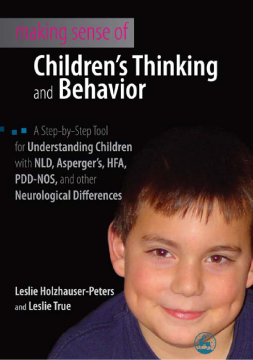
Additional Information
Book Details
Abstract
Making Sense of Children's Thinking and Behavior offers parents and professionals a tool for understanding children with neurological differences. These children have an atypical view of the world, unique to their particular disability, which can make their behavior confusing and, at times, challenging. Often, the child's actions are misunderstood and, consequently, they are unfairly punished.
An individualized approach to understanding a child's thought processes can help to resolve these problems. The authors' Systematic Tool for Analyzing Thinking (STAT) offers such an approach. It provides a step-by-step method for understanding a child's behavior by revealing the thought processes behind it. By viewing a situation from the child's perspective, the root of the problem can be identified and one can then effectively address the difficult behavior. Case studies are used to describe the twelve common deficit areas, demonstrating to the reader how to apply the STAT in everyday situations.
This practical book is an invaluable resource for parents and professionals working with children with NLD, Asperger's, HFA, PDD-NOS, and other neurological differences.
The book is very accessible and will sit comfortably with those parents and professionals, who view the world from a medical perspective, where understanding is gained through a within-child deficit model... This book is recommended for those parents and professionals who prefer a diagnostic approach to understanding child development, rather than those who operate in amore socially constructed world.
British Psychological Society, Debate
Leslie Holzhauser-Peters has thirty years of experience working in the public school setting in the fields of Special Education and General Education. She has worked as a Speech-Language Pathologist, Supervisor and Curriculum Consultant and has authored several publications. Over the past few years she has acted both as an advocate and speech language pathologist to her co-author's son Joshua. Leslie True is the mother of three sons. The oldest, Joshua, has been diagnosed with a NLD. She has devoted years to actively campaigning on Joshua's behalf and, for the past year, has worked as an instructional aide for a child diagnosed with a NLD.
I would highly recommend this book to parents and practitioners from education, health and social care. The case studies could also be used to encourage discussions during a training session.
Good Autism Practice
This book gives clear examples of the areas of difficulty experienced by children with autistic features...The authors' Systematic Tool to Analyze Thinking could be easily implemented by speech and language therapists and mainstream school staff in regular contact with the children. It promotes the benefits of thinking about the thought processes that drive the children's actions...I enjoyed thsi book because it is easy to dip in and out of, and provides good value for money.
Speech & Language Therapy in Practice
Finally there is a concrete, step-by-step, process to help parents (and anyone who lives or works with these children) to figure out what may be underlying the thoughts and actions of neurologically different children... I find this book to be definitely a step in the right direction to help bridge the gap in understanding that often exists between people who are neurologically diverse. I applaud the effort and strongly recommend it for anyone who lives or works with someone with neurological differences... child or adult.
Making Sense of Autism
Ms Holzhauser-Peter and True provide a practical guide to deciphering and translating cognitive, communication and behavioural aspects of children they categorize as neurologically different.
Journal of Autism and Developmental Disorders
From case studies to help describe the twelve common deficit areas to applying the STAT formula to common scenarios, this is a practical resource for parents and professionals working with kids, and an invaluable guide for any special education collection.
The Midwest Book Review
Table of Contents
| Section Title | Page | Action | Price |
|---|---|---|---|
| Acknowledgments | |||
| 1. Introduction: opportunities and challenges for inclusive value chain development | |||
| Part 1: Context for value chain development | |||
| 2. Value chain development for poverty reduction: A reality check and a warning | |||
| 3. Maize diversity, market access and poverty reduction in the western highlands of Guatemala: Mountain development and research | |||
| 4. Stuck in a rut: Emerging cocoa cooperatives in Peru and factors that influence their performance | |||
| 5. What is cocoa sustainability? Mapping stakeholders’ socio-economic, environmental, and commercial constellations of priorities | |||
| 6. Development impact bonds: Learning from the Ashaninka cocoa and coffee case in Peru | |||
| Part 2: Design and implementation of VCD | |||
| 7. Fit for purpose? Review of tools for gender–equitable value chain development, 2018: Development in practice | |||
| 8. Building frontline market facilitators' capacity: The case of the ‘integrating very poor producers into value chains field guide' | |||
| 9. Value chain development in Nicaragua: Prevailing approaches and tools and persistent gaps | |||
| 10. Value chain development in Vietnam: A look at approaches used and options for improved impact | |||
| 11. Making markets work for women: How push and pull strategies can support women's economic empowerment | |||
| 12. Variation in smallholder strategies and capacities, and implications for effective targeting for value chain development | |||
| 13. Complexity in value chains and implications for businesses and development agencies | |||
| 14. Microfinance plus for ecosystem services: A territorial perspective on Proyecto CAMBio in Nicaragua | |||
| 15. Impact of an agricultural value chain project on smallholder farmers, households, and children in Liberia | |||
| 16. Practical lessons on scaling up smallholder-inclusive and sustainable cassava value chains in Africa | |||
| 17. Gender mainstreaming in value chain development: Experience with gender action learning system in Uganda |
